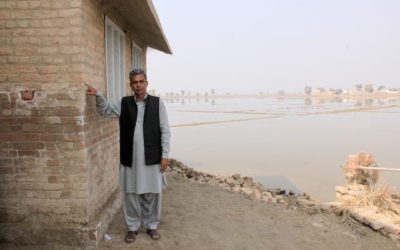Migration is a successful climate adaptation strategy
Migration is a successful climate adaptation strategy
Image: Diving Near Slums of Cebu City Philippin” (CC BY-NC-ND 2.0) by AdamCohn
After a particularly bad year for rainfall, Miguel told a group of researchers that he was leaving Mexico for the US. This wasn’t a permanent move he explained, he would be back. In fact, he’d made the move several times before.
“The only solution is to go away, at least for a while. Each year, I’m working for three to five months in Wyoming. That’s my main source of income.” The ability to cross the border and find work in the US has become a lifeline for many of Mexico’s farmers. For many, their plan is not to move permanently and settle.
But rather to use temporary migration as a safety net against drought. “My grandfather, father and I have worked these lands,” he told the researchers. “But times have changed … The rain is coming later now, so that we produce less.”
It is in these years of reduced cropping that people make journeys like Miguel’s. Typically people move alone, without their family members. The aim is to earn enough money to replace the lost farming income. And possibly to send money back to family members who have stayed behind. In particularly bad years, this flow of money from overseas is what keeps small farms afloat.
It was over a decade ago that these researchers spoke to Miguel and other people in his situation. Trump’s threat of a border wall, and an increasingly hostile environment for migrants in the US makes journeys like this harder and more dangerous.

Online Q&A: Covid-19, climate change and migration: 14th May at 3pm BST
Online Q&A session14th May at 3pm BST14th May at 3pm BSTHow does a city in lockdown deal with a sudden climate-driven disaster like a typhoon? The measures needed to cope with a sudden episode of displacement - such as mass emergency shelters - are exactly the...
For millions of people across the world, this pattern of migration is becoming a form of climate change adaptation. As the impacts of climate change begin to take hold, droughts become longer and more severe. This inevitably hits agriculture.
Hindou Oumarou Ibrahim, an indigenous woman from the Mbororo pastoralist community of Chad, explained her situation to the UN’s Migration Agency. “Migration has now become an inevitable method of adaptation for us … As a means of survival for us and our animals, we are forced to continuously migrate despite all the risks involved.”
For pastoralists, migration has always been a way of coping with altered weather patterns. However, many pastoralists are now caught in a trap. Climate change is amplifying droughts and changes in rainfall. At the same time, migrating is becoming harder due to conflicts and tougher border controls.
Ibrahim explained to the UN, “This is our form of adaptation. We have always mastered it, but if nothing is done to ensure the safety of our space and activities, we risk, one day, being forced to abandon our way of life and join the swelling ranks of the unemployed in the city.”
The choice here is between continuing a difficult, but effective form of migration that ensures survival, even in the face of drought. Or, if this becomes impossible migrating permanently to a city.
Billions are spent every year trying to make agriculture resilient to climate effects. But for people who are already poor, even slight reductions in farming income can be catastrophic.
Migration and finding alternative work has, therefore, become part of their safety net in the face of climate change. Migration has become a form of home-grown climate change adaptation.
Migration usually comes with risks and costs. As these increase, this vital form of climate adaptation becomes harder. Worryingly, this is happening at exactly the point when all possible forms of climate adaptation need to be on the table. Especially ones that are already working for millions of people across the world.
To harness, rather than stifle, this form of climate adaptation, several things need to happen.
Online Q&A: Covid-19, climate change and migration: 14th May at 3pm BST
Online Q&A session14th May at 3pm BST14th May at 3pm BSTHow does a city in lockdown deal with a sudden climate-driven disaster like a typhoon? The measures needed to cope with a sudden episode of displacement - such as mass emergency shelters - are exactly the...
Climate, migration, neoliberalism
The lecture sketches out a history of neoliberalism, and then looks at how the culmination of this political thinking is reflected in the policies that are being created to address climate change and migration.
By creating new visas and new legal migration options governments could extend this pattern. People would have more options and more choices about where they move to. This would further strengthen migration as a climate adaptation strategy.
Governments often fail to understand that people will migrate, even if a safe, legal option doesn’t exist. Governments have a stark choice ahead of them. They can either facilitate safe, legal migration. Or they can attempt to stop people moving and create crises like the one that is currently unfolding along Europe’s southern coastline.
As the impacts of climate change begin to bite, more and more people will want to move as a way of adapting to climate change.
Governments should be harnessing, rather than preventing, the use of migration as a climate adaptation strategy. Governments must begin to understand that allowing this to happen, making it legal and facilitating it is their best option. The alternative is trying to prevent it and creating a crisis.
Online Q&A: Covid-19, climate change and migration: 14th May at 3pm BST
Online Q&A session14th May at 3pm BST14th May at 3pm BSTHow does a city in lockdown deal with a sudden climate-driven disaster like a typhoon? The measures needed to cope with a sudden episode of displacement - such as mass emergency shelters - are exactly the...
Climate, migration, neoliberalism
The lecture sketches out a history of neoliberalism, and then looks at how the culmination of this political thinking is reflected in the policies that are being created to address climate change and migration.
Climate change and migration: predictions, politics and policy
Get to grips with one of the defining issues of the 21st Century – how will climate change re-shape migration across the world. Join a free, 100% online course to investigate this essential topic
Event: Migration and displacement at the climate talks
How are migration and displacement being dealt with at the international climate change talks? Find out more with our online event
Event: Climate change and Migration 101. 4 December
Get to grips with the links between climate and the movement of people
Event: hot wars- Climate change, armed conflict and security. 15 November
What do we know about the links between climate change and conflict? Will life on a hotter planet be on with more armed violence?
Briefing: climate change and migration. 24 October, London
An evening briefing exploring the links between climate change and migration. Find out more and book places. 24 October, London
Workshop on climate change and migration. 16 October, London
Workshop on climate change and migration. A half-day session exploring the links between climate change and migration. 16 October, London






